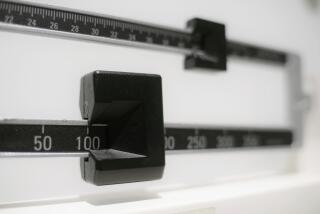Hop on a treadmill at your desk: It works!
- Share via
Those zany “walk and work” researchers at Mayo Clinic may be on to something.
Dr. James Levine, an endocrinologist and professor of medicine in Rochester, Minn., has fresh evidence that it’s not only possible to perform routine office work while walking very slowly on a treadmill built into a workstation, but the worker may burn about 120 extra calories an hour while doing so.
Under laboratory conditions, 15 obese volunteers boosted their regular energy expenditure of 72 calories an hour to 191 calories an hour when they traded a chair for a treadmill moving at about 1 mile per hour.
Even working only three hours a day on the treadmill could translate, conservatively, into a weight loss of 2 pounds a month.
Levine has followed up on the study, which was published in last week’s issue of the British Journal of Sports Medicine, with a much bigger test of the system at three Fortune 20 firms and one smaller company. Those findings have yet to be published, but preliminary results are promising. Many of the workers have asked to keep their treadmills.
Shrugging off occasional snickers, Levine believes the calorie-burning potential for his obese patients is enormous. “This is a way of burning a lot of calories painlessly,” he says.
He also reports that it’s actually very hard to fall off the back of the treadmill while working. “Even if you get transfixed by the world’s most fascinating e-mail or you finally got that promotion and you’re so stunned you stop moving your legs, you still remember to take that step forward at the critical last moment. I’ve never seen someone fall off the back.”
*
Even next to nothing’s better than nothing
For those who’ve adopted a zero-exercise policy, here’s a reason to rethink that strategy.
In a study of 464 postmenopausal women divided into four exercise groups, Dr. Timothy Church of Pennington Biomedical Research Center in Baton Rouge, La., found that women who performed just 72 minutes of exercise a week over a six-month period got a 4.2% boost in cardiovascular benefits over participants who did nothing at all.
The results were based on standard measures of oxygen consumption while exercising.
Although 4.2% may not sound like much, the completely sedentary person will generally lose 1% to 2% in fitness each year, says Church.
Church also found a “dose response” to exercise. Subjects who exercised 136 minutes a week (close to the current public health recommendation of 150 minutes) gained 6% in fitness and those who exercised 192 minutes gained 8%.
“This provides evidence that something is better than nothing” for those who’ve stopped exercising because they can’t get the recommended amount, says Church. “This is a positive message for the couch potato.”
*
Luring couch potatoes into a fitness Web
The Internet -- usually associated with luring hunch-shouldered Web surfers into chairs rather than getting them moving -- may be just as effective as printed materials in motivating sedentary adults to exercise, says a new study published last week in the Archives of Internal Medicine.
Lead author Bess Marcus, a psychologist at the Miriam Hospital and Brown Medical School in Providence, R.I., randomly assigned 249 highly sedentary adults to one of three groups.
A “tailored Internet” group received materials over the Internet geared to their fitness goals, including tips for maintaining a fitness regimen. The group kept daily online activity logs and received online questionnaires. A “tailored print” group received similar information through the mail.
A third, “non-tailored” Internet group received links to basic physical activity websites and was asked to complete logs and questionnaires online, but did not receive feedback reports.
After six months, the tailored Internet group was logging about 120 minutes of activity a week, the tailored print group was doing about 113 minutes, and the non-tailored Internet group was bringing up the rear with 90 minutes.
“Print-based and mail-based approaches for years have consistently shown effective results,” says Marcus. “So finding that this Internet program works just as well means we can offer programs to many more people at the same time, without any additional cost. From a public health perspective, that’s very exciting.”
*






